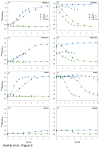A gene island with two possible configurations is involved in chromatic acclimation in marine Synechococcus
- PMID: 24391958
- PMCID: PMC3877281
- DOI: 10.1371/journal.pone.0084459
A gene island with two possible configurations is involved in chromatic acclimation in marine Synechococcus
Abstract
Synechococcus, the second most abundant oxygenic phototroph in the marine environment, harbors the largest pigment diversity known within a single genus of cyanobacteria, allowing it to exploit a wide range of light niches. Some strains are capable of Type IV chromatic acclimation (CA4), a process by which cells can match the phycobilin content of their phycobilisomes to the ambient light quality. Here, we performed extensive genomic comparisons to explore the diversity of this process within the marine Synechococcus radiation. A specific gene island was identified in all CA4-performing strains, containing two genes (fciA/b) coding for possible transcriptional regulators and one gene coding for a phycobilin lyase. However, two distinct configurations of this cluster were observed, depending on the lineage. CA4-A islands contain the mpeZ gene, encoding a recently characterized phycoerythrobilin lyase-isomerase, and a third, small, possible regulator called fciC. In CA4-B islands, the lyase gene encodes an uncharacterized relative of MpeZ, called MpeW. While mpeZ is expressed more in blue light than green light, this is the reverse for mpeW, although only small phenotypic differences were found among chromatic acclimaters possessing either CA4 island type. This study provides novel insights into understanding both diversity and evolution of the CA4 process.
Conflict of interest statement
Figures







References
-
- Kirk JTO (1994) Light and photosynthesis in aquatic ecosystems. Cambridge, UK: Cambridge University Press.
-
- Morel A, Gentili B, Claustre H, Babin M, Bricaud A, et al. (2007) Optical properties of the" clearest" natural waters. Limnol Oceanogr 52: 217-229
-
- Sidler WA (1994) Phycobilisome and phycobiliprotein structures. Molecular Biology of Cyanobacteria: 139-216.
Publication types
MeSH terms
Substances
LinkOut - more resources
Full Text Sources
Other Literature Sources

